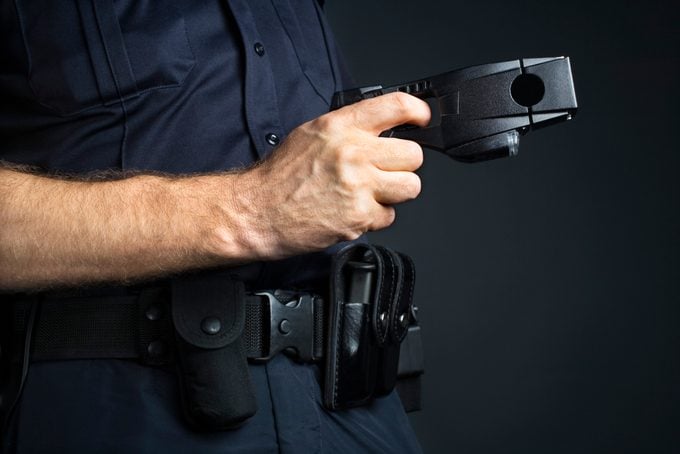Here’s What Happens When You Get Tased—and What to Do
Updated: Mar. 29, 2021
Tasers may not be as dangerous as you think, but they still pose a significant risk if you fall into one of these categories.
In a sign of the continuing unrest gripping the United States after the death of George Floyd in Minneapolis, two Atlanta police officers recently lost their jobs after tasing two students from two historically black colleges and dragging them from their car during last week’s protests in the city.
Tasing is not often used in crowd-control situations but is frequently used by police officers against individuals. “It’s very much targeted toward a single individual whereas other weapons [such as rubber bullets and tear gas] are used more for crowd control,” says Ian Wittman, MD, chief of emergency medicine at NYU Langone Hospital–Brooklyn.

How does a taser work?
There are two types of tasers, explains Dr. Wittman. One delivers an electric current when it is pressed directly against a person. The other fires two barbs into the person. “Electrical currents travel through the attached wires,” he says. “Police departments usually use the barbed tasers because you don’t need to be in physical contact.” According to the Stanford Criminal Justice Center, the devices deliver 50,000 volts of electricity meant to overwhelm the central nervous system. The shocks are delivered in bursts of five seconds, but this can go on indefinitely if the finger stays on the trigger. (Make sure you know about ways to handle a medical emergency.)
Guidelines for using tasers
American Public Media Reports, an organization that focuses on independent investigative and documentary journalism, says that about 400,000 American patrol officers carry tasers. There are different guidelines for how to use tasers, including some from the American Civil Liberties Union. First off, officers need to be trained. They also need to issue a verbal warning, such as, “Stop, get on the ground, or you will be tased” and avoid targeting the face, neck, and groin. Other guidelines include refraining from using a taser if a person could fall.
The Stanford Criminal Justice Center recommends that tasers never be used on children, pregnant women, elderly individuals, people who are mentally ill, and/or under the influence of drugs.
What it feels like to be tased
A taser essentially stuns you, hence the moniker “stun gun.” “You can expect to feel just a total loss of muscle tone and the inability to move anything for a brief period of time,” says Corey Slovis, MD, chairman of the department of medicine at Vanderbilt University Medical Center as well as medical director for the Nashville fire department and airport. “You’re truly stunned and are not able to move anything.”
One person who was tased described shooting, excruciating pain that shook his brain like a “peanut in a jar.” Another person said she felt like bees were crawling through her skin.

Can a taser kill you?
Compared to other measures used to subdue people, tasers are actually relatively safe and were deployed for people not obeying commands to get down on the ground. “Originally, they could be used with impunity because they immobilized a person without inflicting permanent damage unless someone got shot in the eye,” says Dr. Slovis.
But they have resulted in harm, even death in certain groups of people. People who have died after being tased generally have been described as “agitated” or in a state of “excited delirium.” “Almost all of them have a history of psychiatric disease or have cocaine or other stimulants on board including also having alcohol,” says Dr. Slovis. The deaths have also typically occurred after multiple shocks, he adds.
The possibility of heart damage
Despite the fact that tasers deliver a 50,000-volt jolt, it is thought that there is little risk of cardiac or heart problems, according to Dr. Slovis. However, the risk might be understated because much of the data comes from research on healthy volunteers. “There’s a minimally elevated risk for people with underlying cardiac issues,” he says. Even outside of study settings, Dr. Slovis adds, “there have been autopsies performed where they can’t find any structural heart disease and attribute it to abnormal rhythm either precipitated by delirium or the delirium plus taser.”
According to Robert Glatter, MD, an emergency physician in New York City, people who have been tased have “suffered seizures and cardiac arrest and dangerous arrhythmia like ventricular fibrillation.”
Risk of a taser barb injury
“The barbs themselves are shot as a projectile at high speed,” says Dr. Wittman. “They look like little fish hooks which keeps them embedded.”
“In rare cases, they can cause significant damage or bleeding to structures and, in very unlucky cases, significant damage to eyes if they’re shot into eyes,” he adds. “My understanding is that the training is to aim for the center chest and back so as to avoid hitting faces but, theoretically, if they hit the eye, there’s a pretty significant chance might lose vision.”
One man who was tased after speeding in California said that one of the barbs settled so deep that he needed surgery to remove it.
Other possible health effects of tasers
Some people have experienced minor trauma when the tased have fallen onto hard objects, says Dr. Slovis. And in one randomized, controlled 2015 study published in Criminology & Public Policy, researchers found that healthy volunteers who were tased experienced diminished short-term memory and trouble processing new information.
The Stanford report found that the muscle contractions produced by tasing can result in strain-type injuries to organs, joints tendons, and ligaments.
What to do if you’ve been hit by a taser
If you’ve been hit by a taser with barbs, make sure you keep the puncture wounds clean, counsels Alberta Health Services in Canada. And be aware that you may have burns and muscle pain. Heat or ice may help with sore muscles, as well as over-the-counter pain relievers.

















